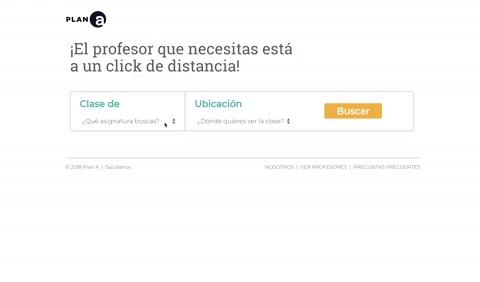plan a
Plan A is a start-up that we created in 2016 in Venezuela, you can see its progression on clasesplana.com
It consists of a platform that lets students find teachers for multiple different kinds of subjects and topics. The start-up is a social venture that uses the "buy one give one" model where one class paid by a user pays for the class of a person in need. We participated in the 2016 start-up IDEAS competition in Venezuela where we won first place for social startups.

Job title and description
I am a member of the start-up as the User Experience Designer and one of the Front-End Developers.
As in every start-up I’ve also participated in other aspects of the business, but I’m in charge of making sure we have the best user experience possible and to implement some of the necessary changes to the website. The team is small, we are 5 permanent members, where only one is full-time, we’ve had multiple collaborators along the way and we’ve been involved more or less depending on our availability.
Idea Validation
To validate the original idea we decided to interview users from both sides of the solution, students and teachers. To create the interview questions, we asked ourselves what we wanted to know and what will help us confirm the idea and make it successful. Once we defined them we proceeded to interview friends and family members who fit the user profiles we defined.
These semi-structured interviews helped us confirm that the users were interested in our idea and its social factor. It also helped us define the necessary and most important features we needed to have in our solution for it to be successful.
We started our solution by creating a landing page to see if there was any interest in the market outside of our friends and family. This landing page didn’t prove to be super successful. The only action the users could do was provide their email, and it didn't help that we didn’t do a strong marketing campaign for it.

Rough sketch of the Landing Page's workflow
Website design
Competitive analysis
After realizing that we needed to provide a more robust solution we started developing our MVP (Minimum Viable Product) with the previously defined features.
For this, I proceeded to research competitors’ websites and perform heuristics evaluations on them. This helped us see which features are most commonly used, how they are implemented, what to copy, and what to avoid copying. With this research, we were able to prioritize which features to implement first. Like for example, deciding to search for location and subject first and then filter amongst the teachers, with the price and bio very clear.

Competitors' Analysis
Front-end Development
At this point, I started to get involved in the front-end development as the second developer of the team, as our CTO had done everything so far. I developed a few pages that have since changed like the FAQs, the Team page, the list of teachers (the hardest and most important one), and I also improved the landing page.
To do this, I would talk with the graphical designer of the team to discuss what made more sense based on my previous research and usability knowledge, and then she would adapt her designs to it and deliver them to me so that I could code them. The pages I developed are no longer available because our CTO quit and I didn’t have the time or the back-end development knowledge necessary to be the CTO; So we paid another developer to develop our solution on WordPress using certain plugins that simplified our lives but added a lot of constraints into what we could do.

List of Teachers

FAQs Page
Usability tests
Once we finally had a functional product, I proceeded to define usability tests in order to improve our solution even further. I defined the tests but didn’t perform them, they were performed by one of our members in person in Caracas with users of the website. This proved to be quite useful but the constraints added by the WordPress plugin didn’t let us implement most of the changes and the decisions I had made before for the teacher search had to adapt to the plugin.
Luckily the plugin we used was updated recently and we’ve been able to implement some of the desired changes. This means that we are getting ready to perform new usability tests to validate them. And we’ll finally fully launch into the market this year, with a strong marketing campaign in Venezuela.

Part of one of the usability tests
Lessons learned
This experience has been one of the most interesting and fulfilling of my life. We started this company before I started my master’s degree, so I was able to immediately apply what I was learning in school: the usability tests, heuristic evaluations, how to properly interview users, front-end development, and many others; into a functioning business, seeing real results and learning even more. As we all know, the academic environment is not exactly like the real world.
Throughout the 4 years the company has existed, we’ve had our ups and downs since we’ve all lived in different parts of the world. But we’ve been able to develop a functioning business that helps people in need; And we are finally getting ready to have a bigger launch by the end of 2020.


